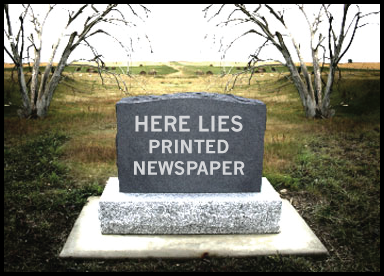
The death knell for newspapers has been sounding for quite some time now. I am only speaking here of newspapers and to a smaller extent magazines. Because the online and social world allows us endless customization for individualism and content targeting, newspapers and non-niche publications are being put on the death spiral. I will probably never want to see the printed book die out, nor the printed niche magazines (how else would I satisfy my vision board and scrap booking cravings!?). After visiting my local Safeway and signing up for two months of the Washington Post in order to get $15 in gift cards for my wine that night, this death knell has never been more apparent.
For the past month I have been receiving piles of paper at my doorstep, that I then bring in and try to harken back to those Norman Rockwell days of yore, making my coffee, sitting down at my counter and getting in an origami battle with the Style section of the Washington Post. Obviously, this is not what they planned. Why can’t I just swipe left and right to go back and forth between articles? Why is it that when I am finally entrenched in a relevant article, I have to all the sudden jump four pages forward – is this a choose your own adventure newspaper?
All of this leads to one inevitable conclusion: Print is Dead! For the following generations, it is something that is better left to the incinerator. But I want to look at this issue from the eyes of a marketer. Sure, print is dead, but that is because we have evolved to better forms of reaching individuals with the content they want. So without further ado, here is a list of the 4 main reasons “why Print is dead and the opportunity it leaves for newspaper companies and marketers”:
- Print casts too wide a net in what it covers, in the hopes that everyone will find something interesting. Nowadays, we can easily be surrounded by only the news and content that we find interesting: zite, huffington post, Flipboard, cool hunting, to name a few. This allows marketer to know how to target the people that will be interested in what they are selling, and it allows print companies to begin curating their news for specific audiences, and making business decisions on “interest” subscriptions (the more interest in a section the more subscriptions that section receives, the less interest in a section means it’s easier for the newspaper to divest in it without hurting the rest of the publication!). Not to mention, effectiveness in ad space will skyrocket, and thus a newspaper can cover more of it’s overhead by just allowing the public to choose what it is most interested in reading.
- As much as I like the idea of a Norman Rockwell calm, serene, contemplative scene; that’s just not the world we live in anymore. We move from thing to thing, hell a poptart now has instructions for a 5 second microwave zapping. Bulky, large format prints cannot be travelled with as easily as a tablet or a smartphone. Here again though, both newspaper companies and marketers can be rewarded for social, local, and mobile advertising. Marketers have the ability now to advertise to people as they walk into or near an establishment. News companies can take advantage of this by bringing news to people from 1-10 miles around where they live or are at that moment! This creates a much more intimate and inviting user experience, and therefore more revenue.
- The greenie eco-conscious person inside me cringes every time I have to throw away a stack of a daily newspaper. Can we just say that the waste and energy it takes to even make, let alone recycle newspapers, could easily be cut out of our cycle. Marketers and newspaper companies could tout themselves from this angle and say how much carbon they have taken out of the air!
- Where’s my like button in this paper? Honestly, what good is reading up on the world events if I have to keep that nugget in my back pocket for a day or two before I can even use it to look knowledgeable at the next Thirsty Thursday? When I read something in a newspaper, after looking for what seems like hours for an article that catches my interest, I want to shout to the world, “HEY! This is interesting, I think you might also like it: world of friends of similar interests.” I can’t think of a better caption for what a marketers dream would be!
MARKETER: you mean to tell me that I can get free advertising, just from a like or share button in my newspaper?
ME: uh. sha.
MARKETER: and… That means other people may subscribe that wouldn’t otherwise been reached… Holy F.
Bottom line: Print should be dead, and newspaper companies should be rejoicing, because now they can finally be a NEWS Company, not just a newspaper company.
